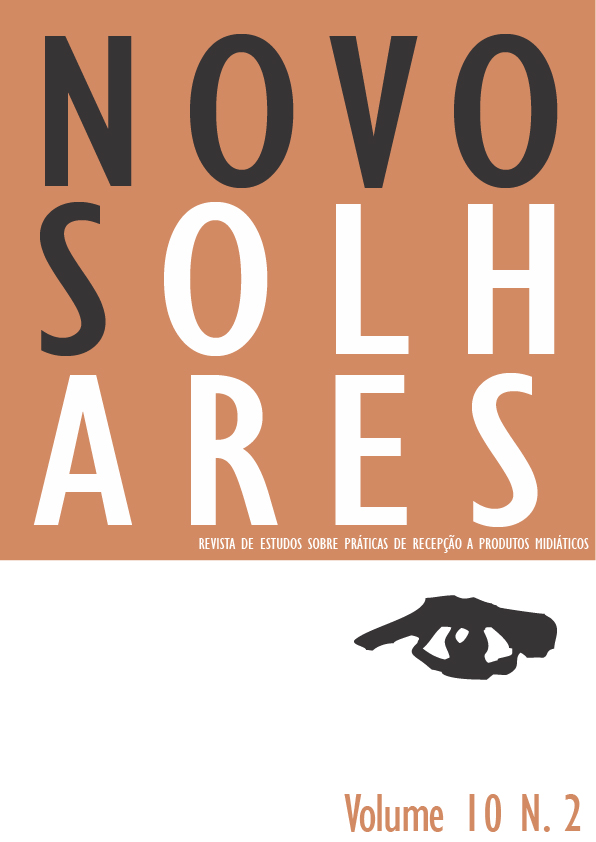Audio-visual volumetry: for a new field of communication studies
DOI:
https://doi.org/10.11606/issn.2238-7714.no.2021.192651Keywords:
Volumetry, Audio-visual, 3D, Communication, MetaverseAbstract
This text raises theoretical and analytical subsidies to propose a new study field in the field of Communication. This field encompasses every type of video that is not characterized by the conventional two-dimensionality of Cinema and TV screens. Its corpus of study is audiovisual tridimensionality or volumetry in its most diverse possibilities. We intend to demonstrate that there is a coherent set of emerging forms of modeling and simulation by 3-D systems that are used in the representation of narratives presented live or on-demand, in exhibition rooms, or on mobile devices, or on the web, in the installation of galleries, haptic interaction systems, and other narrative applications. In particular, we examine the concepts, methods, and approaches used in creating and experiencing these forms of expression. Finally, we reflect on the perspective, textures, and visceral and vestibular senses, as resources already in use to organize, audiovisually, emotional tangles.
Downloads
References
Abbott, E. A. (2002). Planolândia: Um romance de muitas dimensões. Conrad.
Bukatman, S. (2003). Matters of gravity: Special effects and supermen in the 20th century. Duke University.
Cheng, E. (2016). Aerial photography and videography using drones. Peachpit.
D'Anastasio, C. (2021, 4 de novembro). The metaverse is simply big tech, but bigger. Wired. https://www.wired.com/story/big-tech-metaverse-internet-consolidation-business/
De la Peña, N. (2011). Physical World news in virtual spaces: representation and embodiment in immersive nonfiction. Media Fields Journal, 3, 1-13.
Elsaesser, T. (2016). Film history as media archaeology: Tracking digital cinema. Amsterdam University.
Gunning, T. (1997). An aesthetic of astonishment: Early film and the (in)credulous spectator. In L. Williams (Ed.), Viewing positions: Ways of seeing film (pp. 114-133). Rutgers University.
Lankinen, K. et al. (2016). Haptic contents of a movie dynamically engagethe spectator’s sensorimotor cortex. Human Brain Mapping, 37(11), 4061-4068. https://doi.org/10.1002/hbm.23295
Ludman, J. et al. (Eds.). (2002). Holography for the new millennium. Springer-Verlag.
Milgram, P., & Kishino, F. (1994). A taxonomy of mixed reality visual displays. IEICE Transactions on Information Systems, E77-D(12), 1321-1329.
Mihelj, M., & Podobnik, J. (2012). Haptics for virtual reality and teleoperation. Springer.
Panofsky, E. (1999). A perspectiva como forma simbólica. Edições 70.
Shelton, B. et al. (2011). The making of Hong Kong: from vertical to volumetric. Routledge.
Sporer, T., & Brix, S. (2005). Spatialized audio and 3D audio rendering. In O. Schreer et al. (Eds.), 3D videocommunication, algorithms, concepts and real-time systems in human centred communication (pp. 281-295). John Wiley.
Stephenson, N. (2017). Snow crash. Del Rey.
Zone, R. (2007). Stereoscopic cinema and the origins of 3-D film, 1838–1952. The University Press of Kentucky.
Downloads
Published
Issue
Section
License
Copyright (c) 2021 Vicente Gosciola

This work is licensed under a Creative Commons Attribution-NonCommercial-NoDerivatives 4.0 International License.
Proposta de Aviso de Direito Autoral Creative Commons
1. Proposta de Política para Periódicos de Acesso Livre
Autores que publicam nesta revista concordam com os seguintes termos:
- Autores mantém os direitos autorais e concedem à revista o direito de primeira publicação, com o trabalho simultaneamente licenciado sob a Licença Creative Commons Attribution CC Attribution-NonCommercial-NoDerivatives 4.0, que permite o compartilhamento do trabalho com reconhecimento da autoria e publicação inicial nesta revista.
- Autores têm autorização para assumir contratos adicionais separadamente, para distribuição não-exclusiva da versão do trabalho publicada nesta revista (ex.: publicar em repositório institucional ou como capítulo de livro), com reconhecimento de autoria e publicação inicial nesta revista.
- Autores têm permissão e são estimulados a publicar e distribuir seu trabalho online (ex.: em repositórios institucionais ou na sua página pessoal) a qualquer ponto antes ou durante o processo editorial, já que isso pode gerar alterações produtivas, bem como aumentar o impacto e a citação do trabalho publicado.



